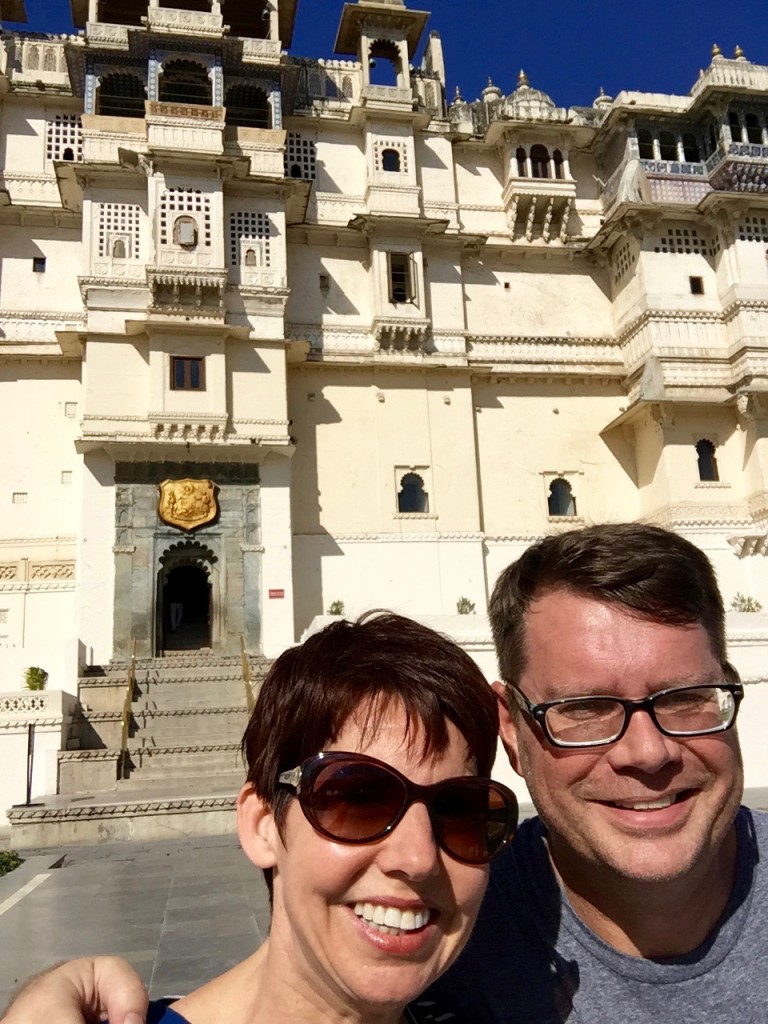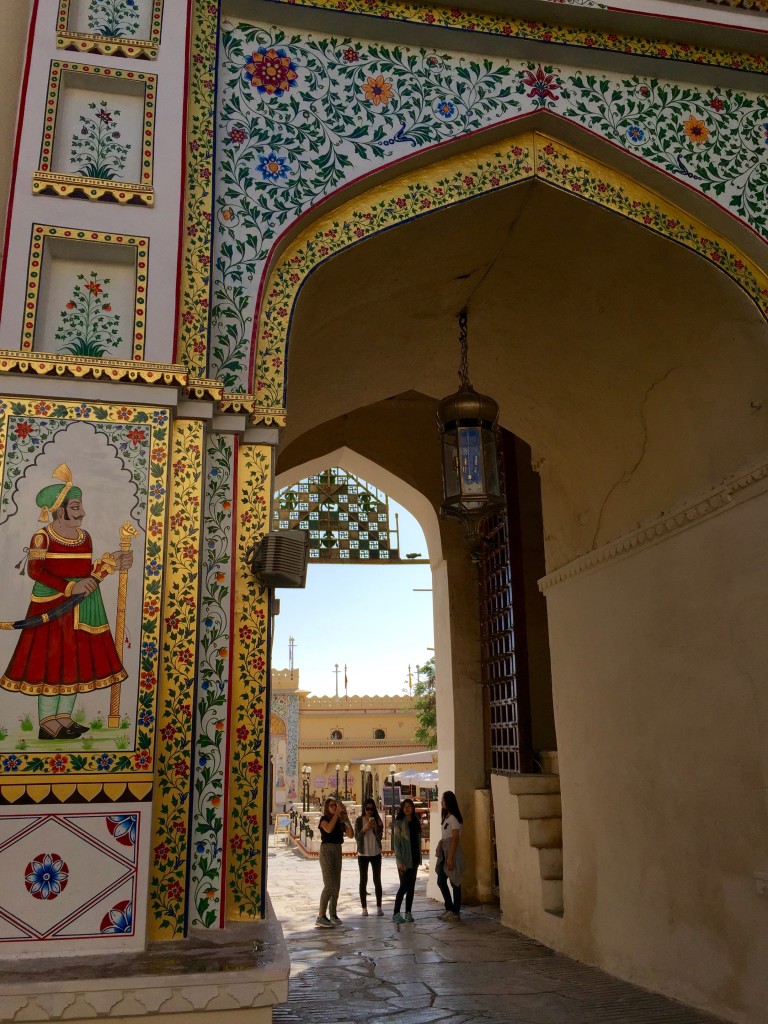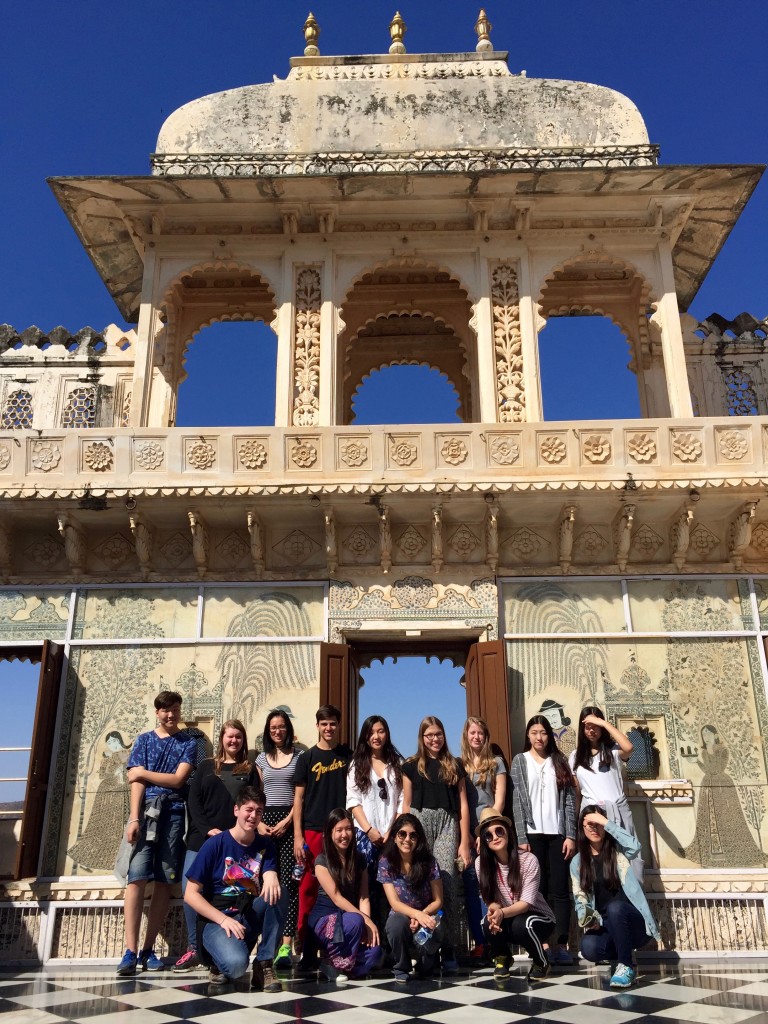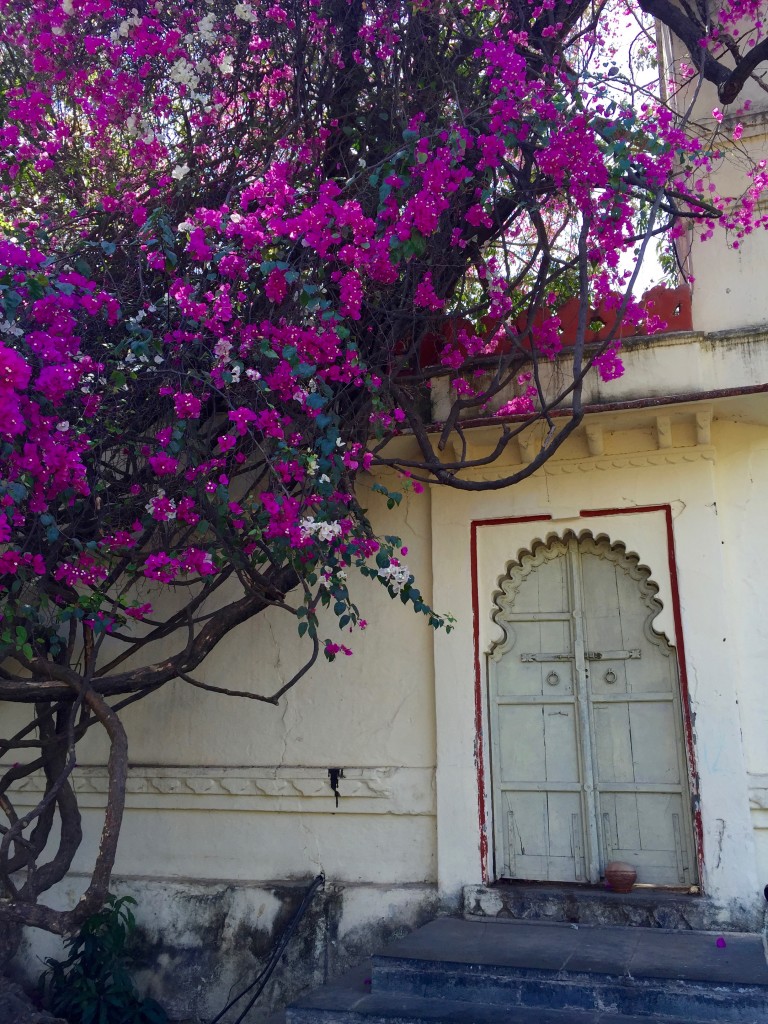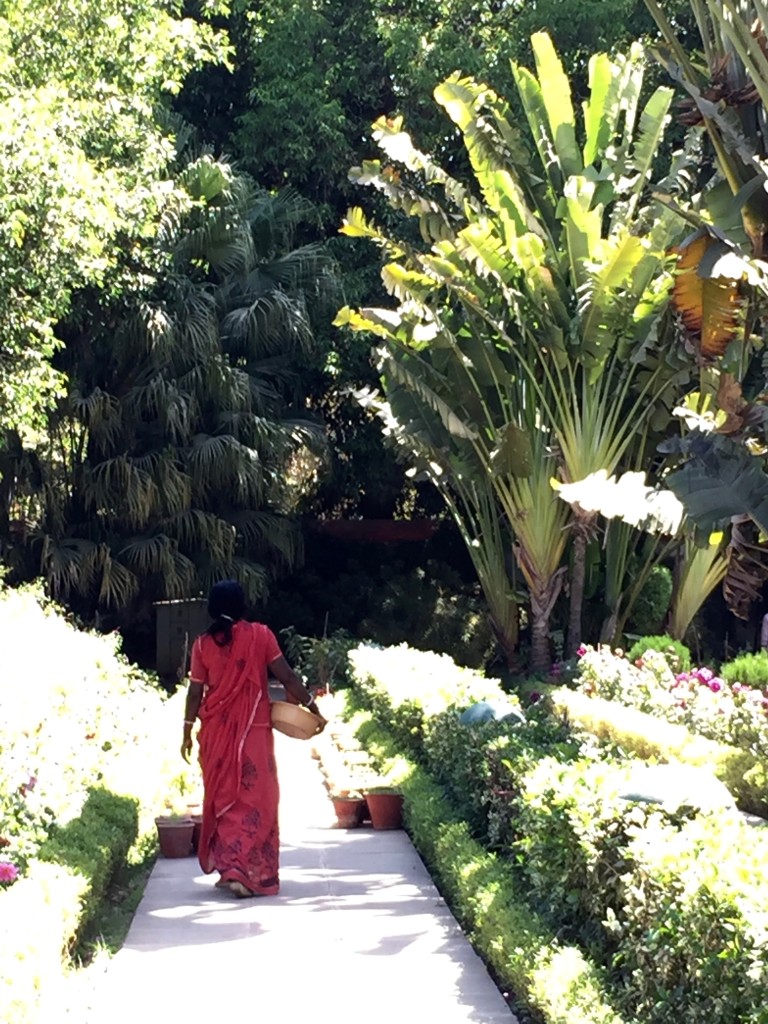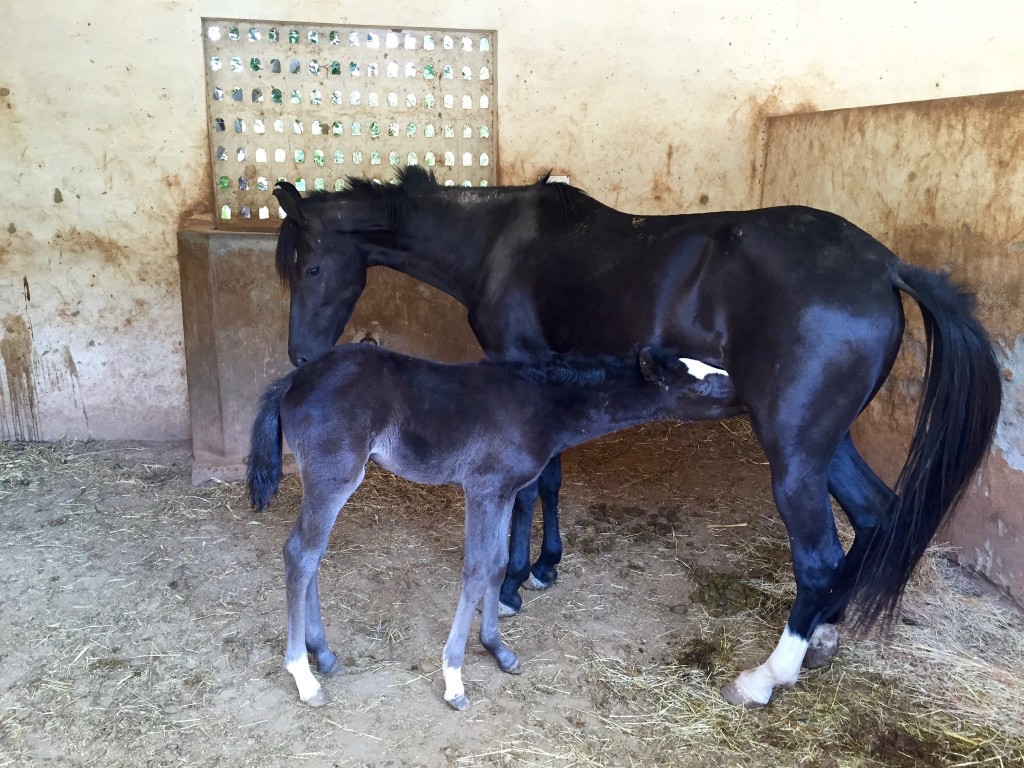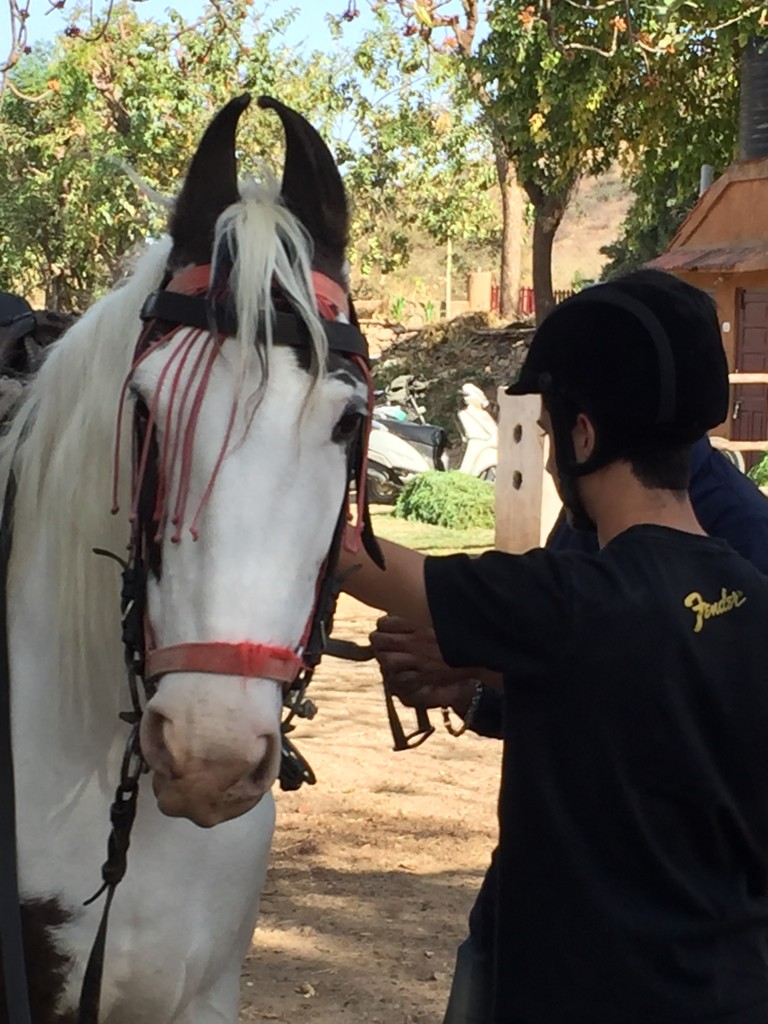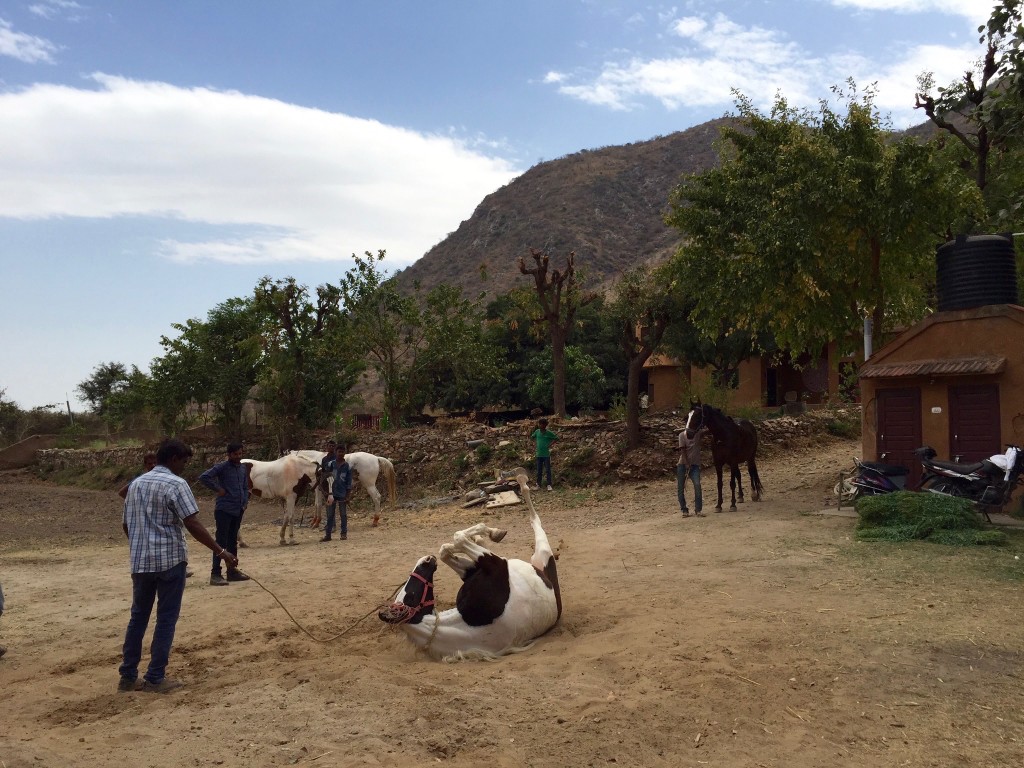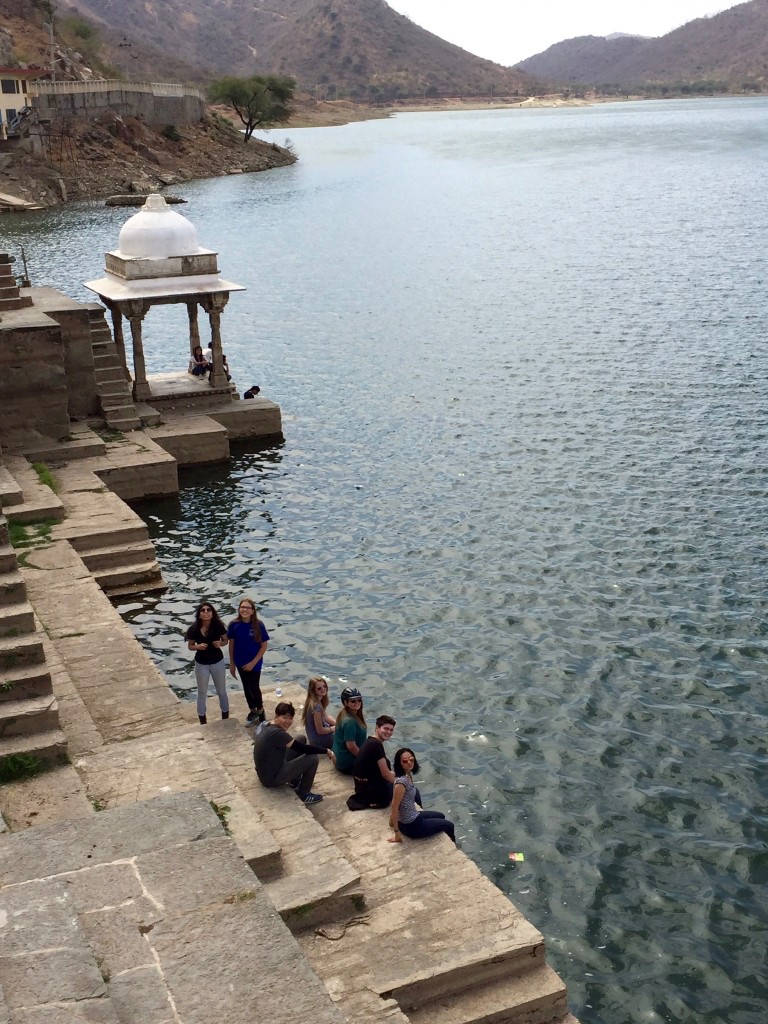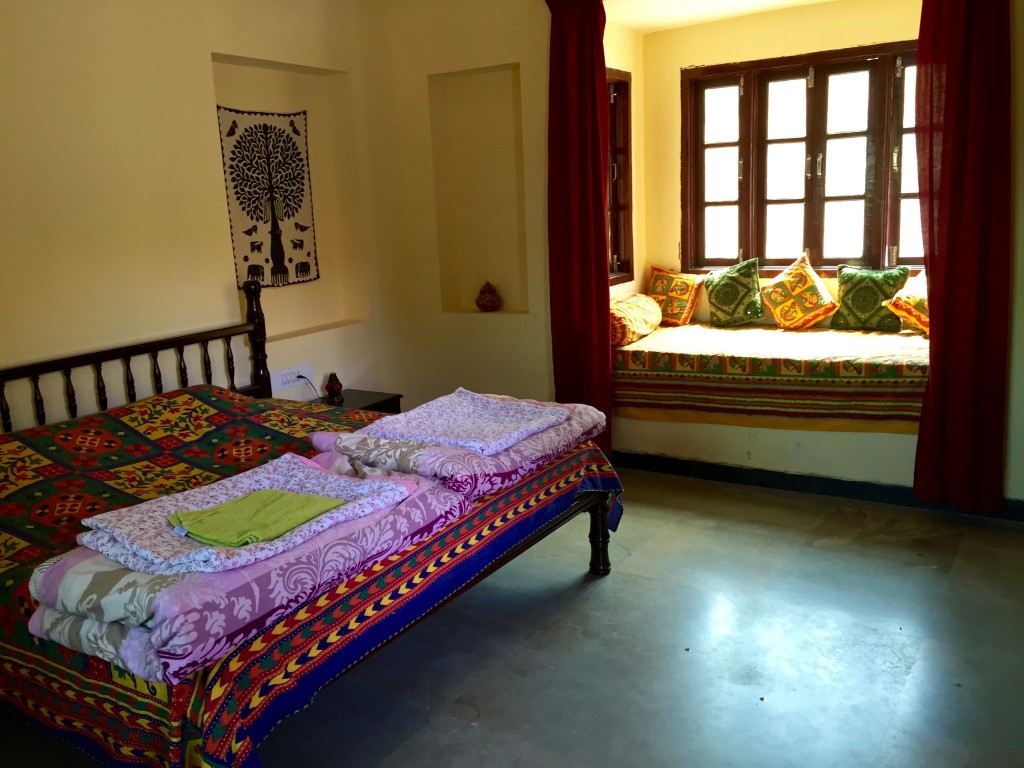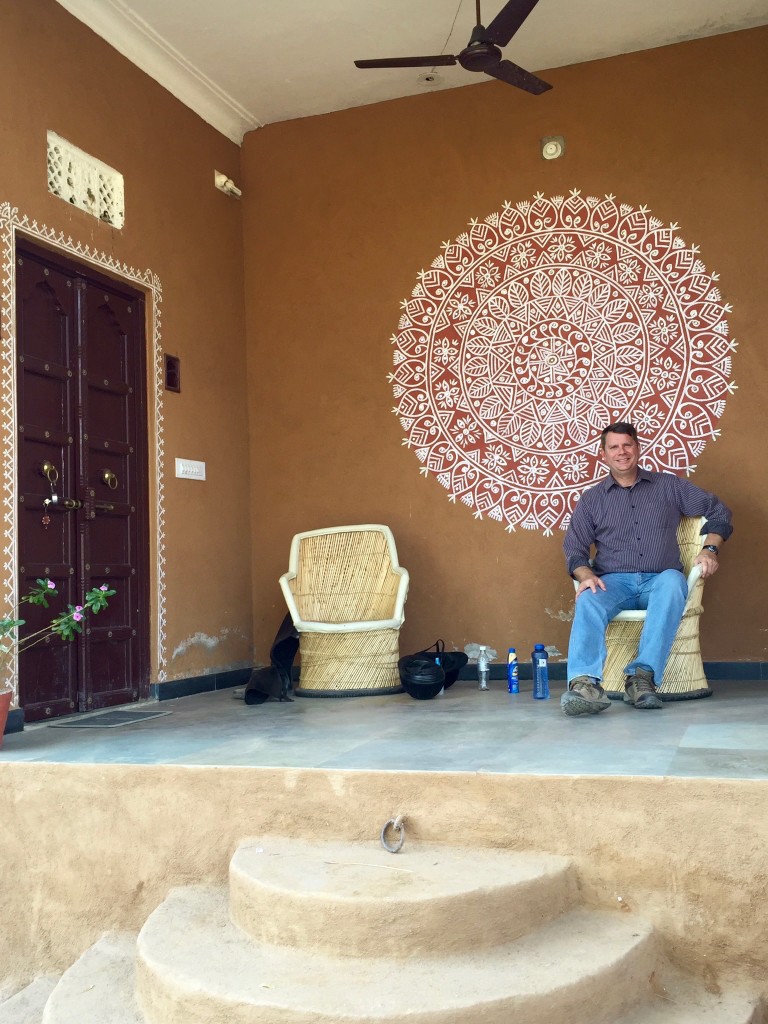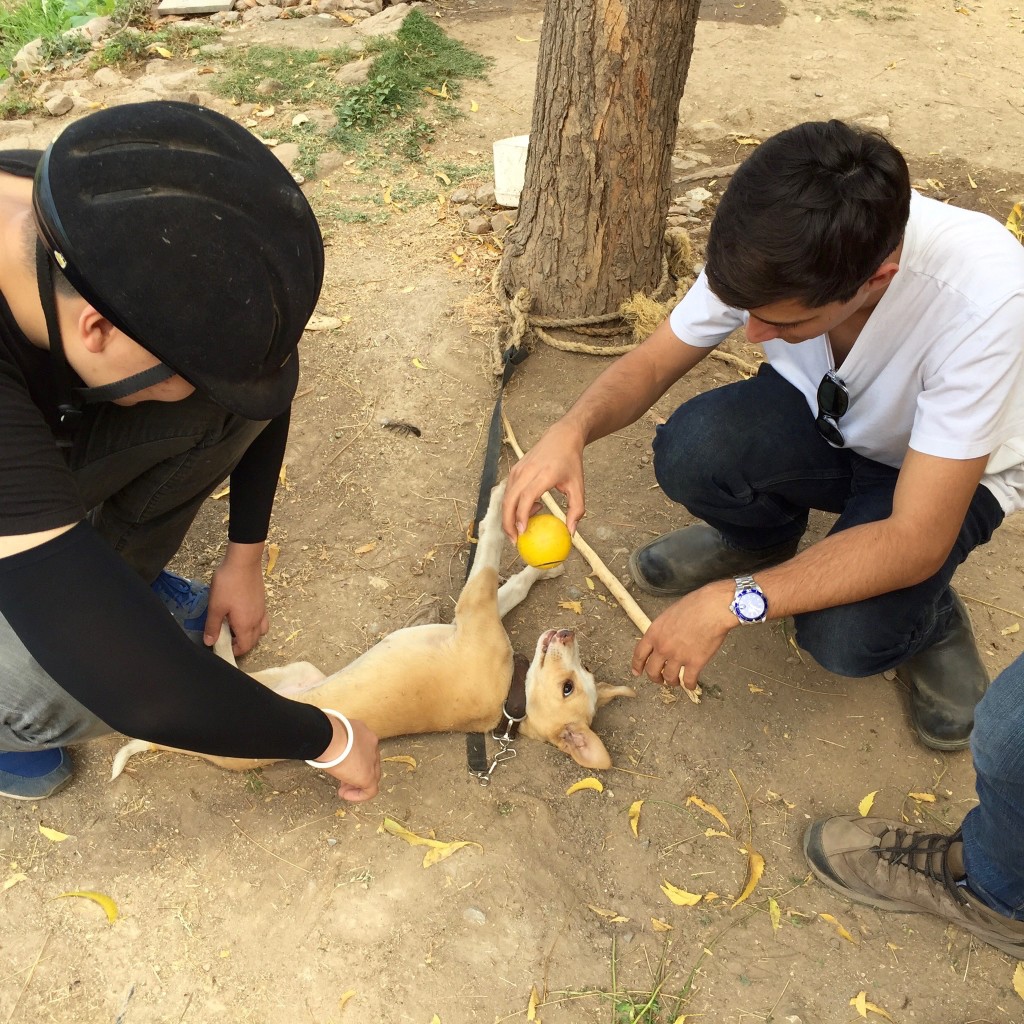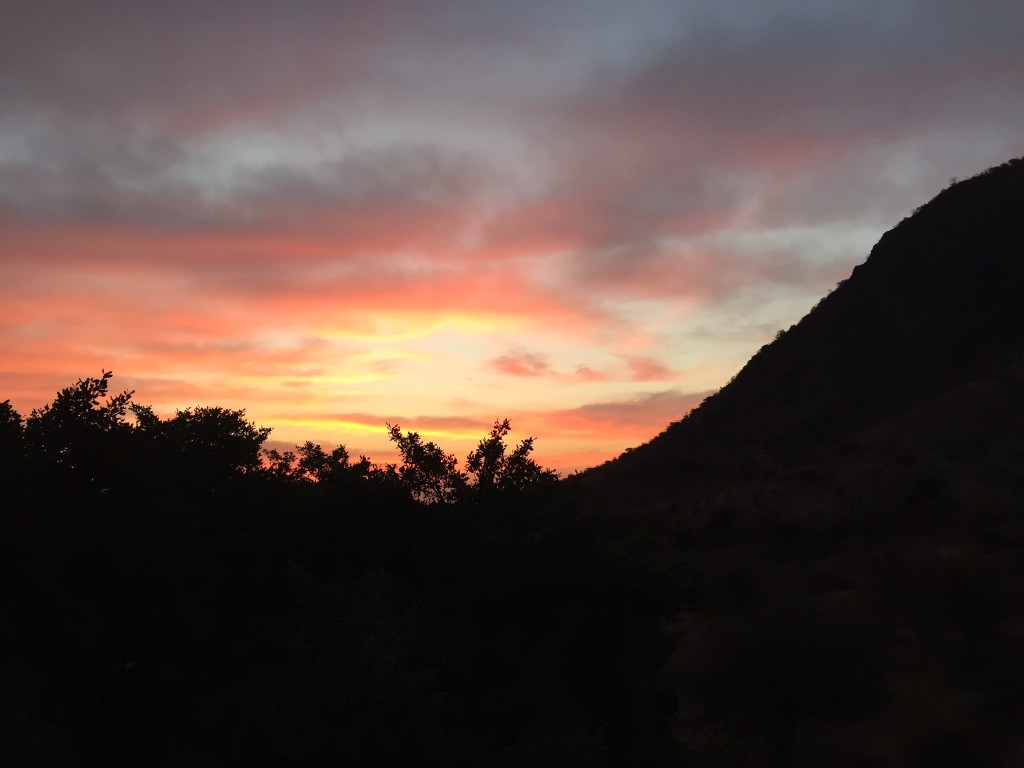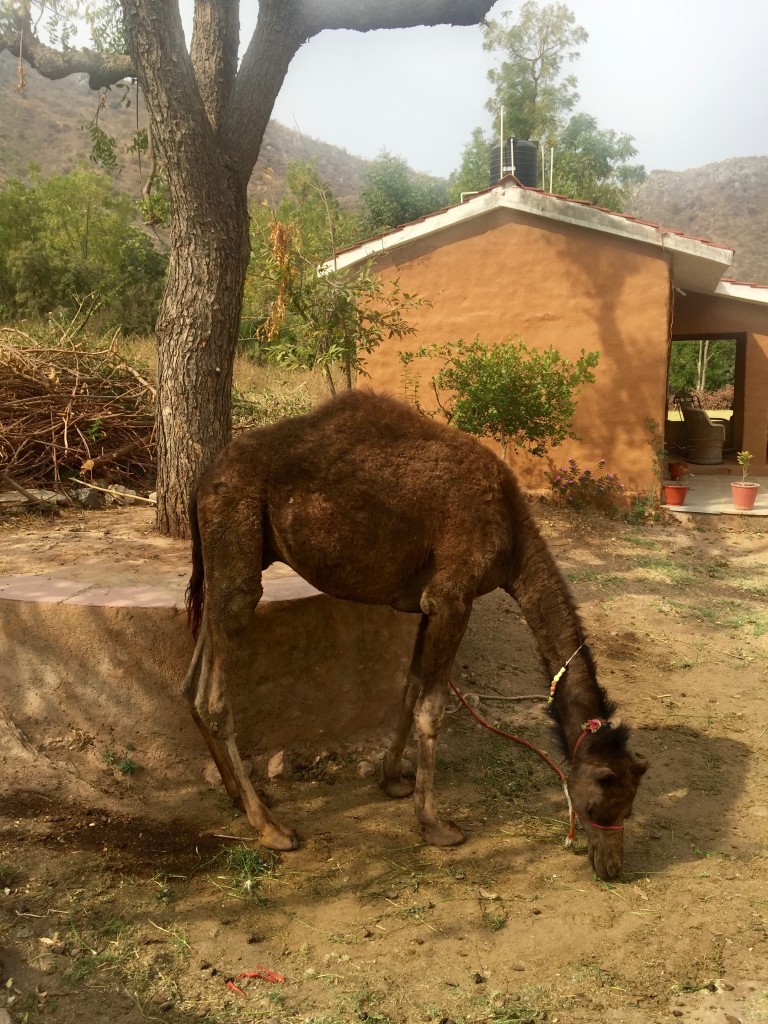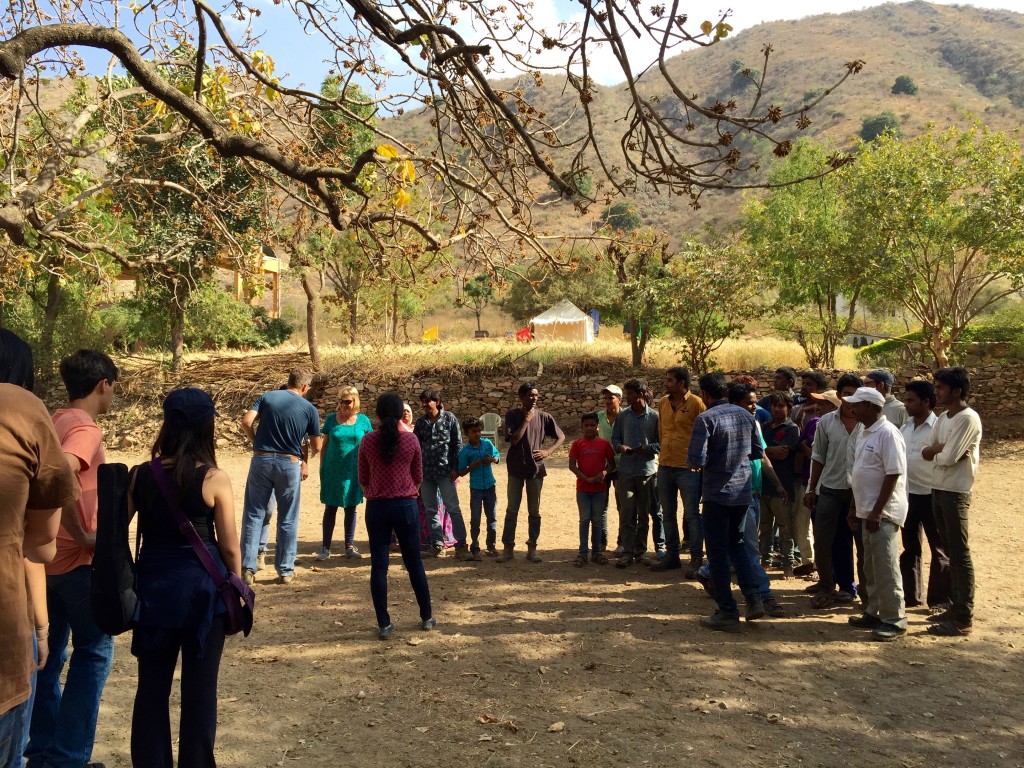Since moving to India, Tony has accompanied high school students on a mini-course called Marwari Safari at a horse ranch in Rajasthan once a year. Although all AES high school students and teachers embark on mini-courses around the country each spring, he always claimed his mini-course was the best. Students got away from the big cities, didn’t have to travel from place to place, learned how to ride horses, enjoyed a little down time every day, and ate delicious food, mostly straight from the garden. For the last four years, I wished I could go, too. This year, I did!
On Thursday, I received a call from the high school assistant principal, saying Tony’s co-chaperone was too sick to travel. Would I be willing to sub? I had a little panic attack. It meant missing a week of school and parent conferences, and this is my busiest time of year as Elementary School EAL coordinator. “Maybe this is just what you need,” she said. Turns out, that was true.
We left just three days later (March 13) on the overnight train: Inder Jit, our tour organizer and riding instructor; his assistant, Bijay; 14 high school students; Tony and me.
After 12.5 hours on the train, we arrived in Udaipur and went straight to a boutique hotel for breakfast in the garden. Afterwards, we toured the City Palace and the Sahelion Ki Bari gardens. I had visited the palace in 2014, but our local guide on this visit had a great sense of humor and pointed out details I hadn’t seen the first time. Many of the students were surprisingly attentive and curious, despite sleep deprivation.
Following our tour, the bus carried us another 20 minutes to Krishna Ranch, our home for four days. We were greeted by ranch owners Dinesh Jain and his wife, Francine, passionate promoters of the Marwari horses and lovely people overall.
Marwari Horses
For a short time, I took riding lessons in Delhi with mostly sluggish horses that slowly and methodically walked the perimeter of the ring. At Krishna Ranch, we rode Marwari horses, which required a whole different approach to riding. Frisky and keenly alert, they were bred for speed and endurance in warfare.
The Marwari horses originated when native Indian ponies were crossed with Arabian horses. The traditional rulers of the Marwar region (in northwestern India) first started breeding Marwari horses in the 12th century. The horses come in a full range of colors and patterns, but their distinctive ears set them apart from other breeds. The ears stand up and curve inward, creating a whimsical and endearing appearance.
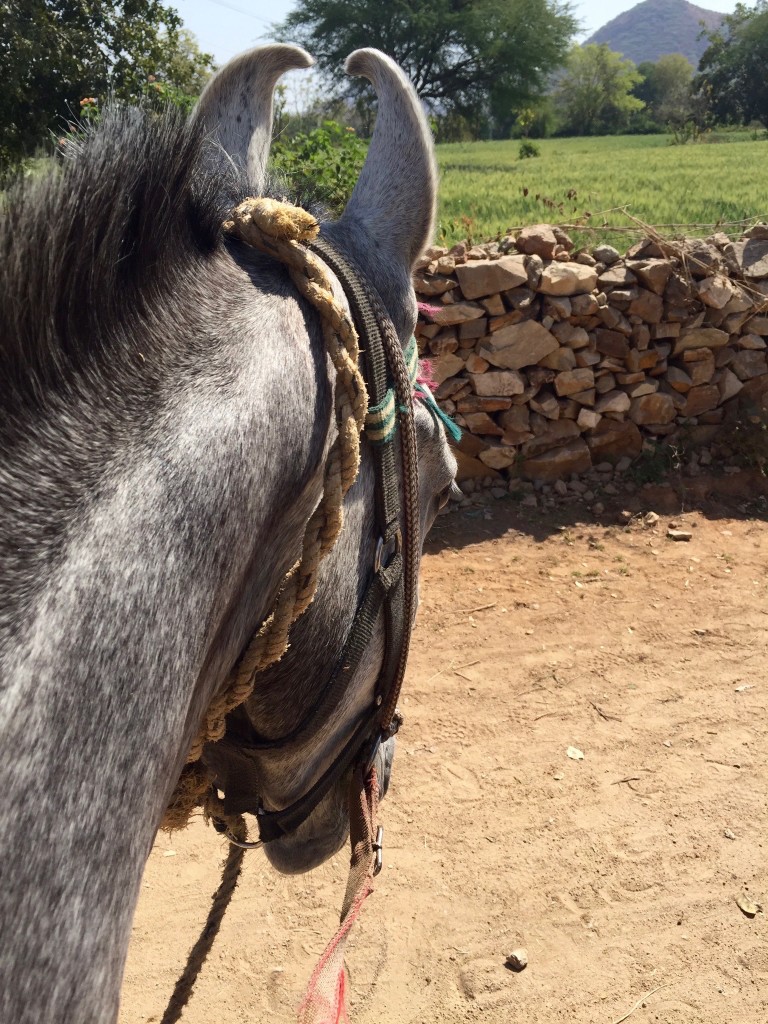
I love this description from the Indigenous Horse Society of India:
The head conveys the indefinable oriental presence of the horse and should be expressive with a high forehead, large sparkling prominent eyes, straight or slightly Roman long face giving a clean chiseled profile and well rounded defined jaws, the nostrils are large and gently flared set over firm fine lips and an even bite. The ears should be of medium length and shapely, curving and curling inwards at their points in a scimitar or lyre shape typical to the breed. They will be somewhat longer in the mare.
Narani, the cook at Krishna Ranch, shares everyone’s passion for these beautiful horses.
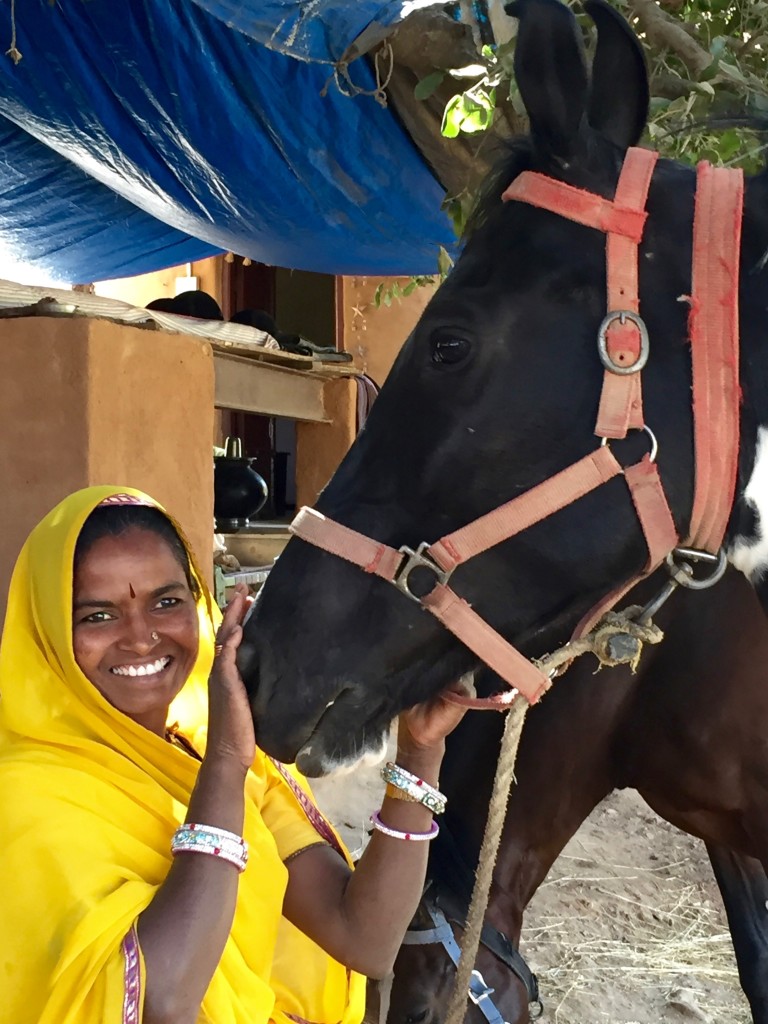
At Krishna Ranch, some light-colored horses had decorative henna socks painted on their lower legs and their Hindi names henna-ed on their flanks.
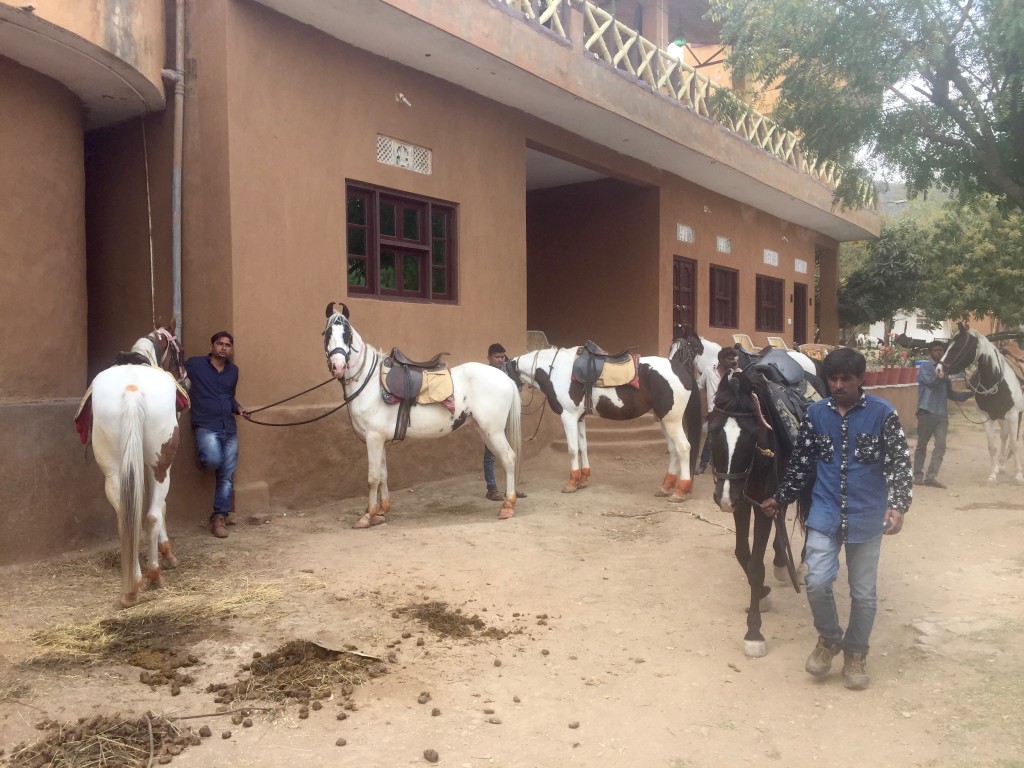
This is Komal. Well, this is Komal’s backside.
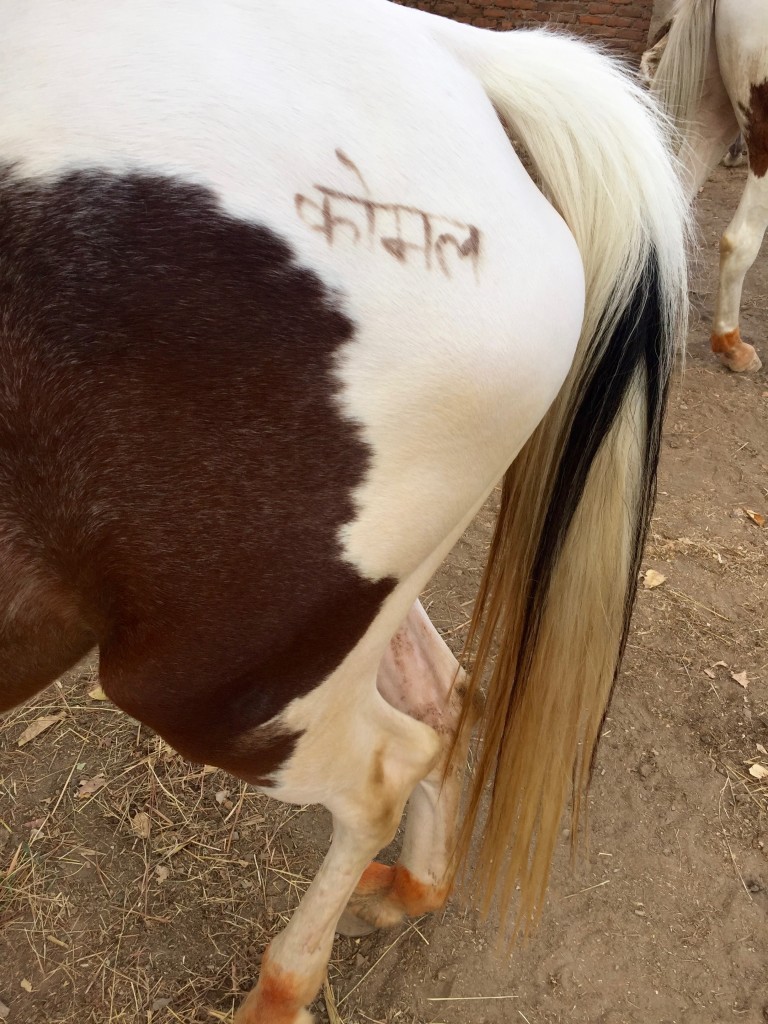
Dinesh and Francine own 14 Marwari horses, and they borrowed a few more for our group. They also breed and sell horses, cautiously entertaining offers from India’s growing upper class. However, Dinesh has been known to buy back a mistreated horse or refuse to make the sale if he feels the prospective owner can’t provide appropriate care. His genuine love and concern for the horses makes this place even more special.
One morning, he saw me peeking over a stall door to check out the youngest resident of Krishna Ranch, so he opened the gate and introduced me to Gori, a 3-week-old black filly with a white blaze. Gori’s father was last year’s champion Marwari stallion, said Dinesh, who petted and cuddled the sweet baby as we chatted. Usually, the young horses are afraid of people, he said, but the workers who groom the mama, Rupali, couldn’t resist brushing little Gori, too. She nuzzled my hand and let me pet her velvety nose.
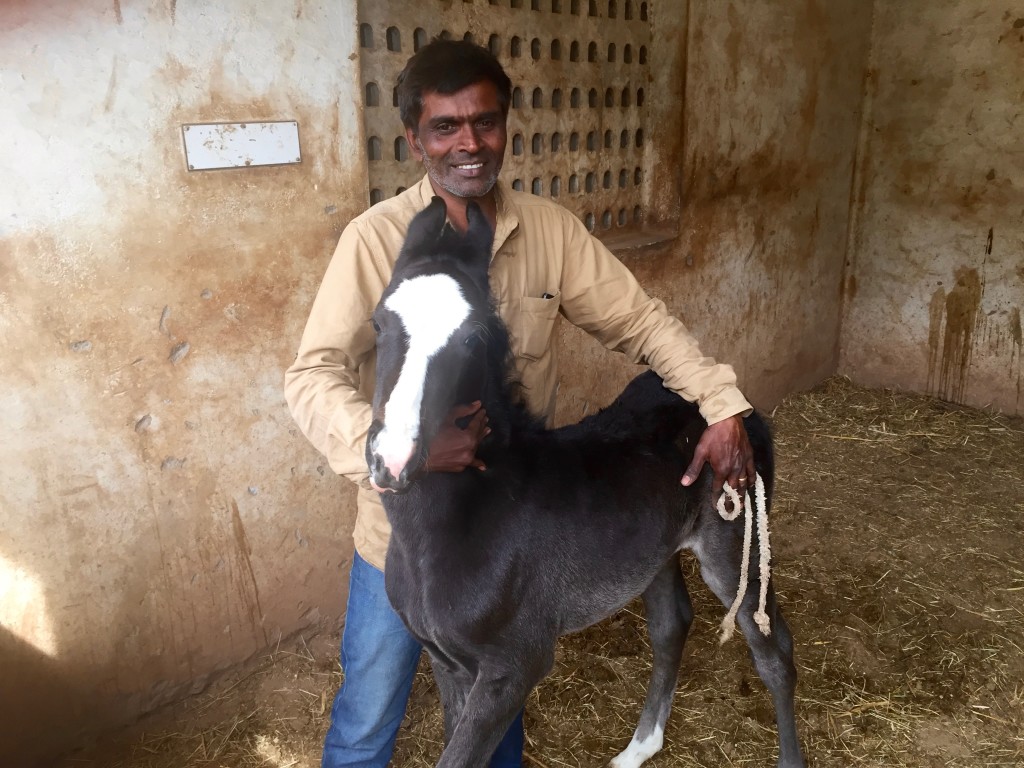
The adjoining stall housed three yearlings, also heartbreakingly adorable.
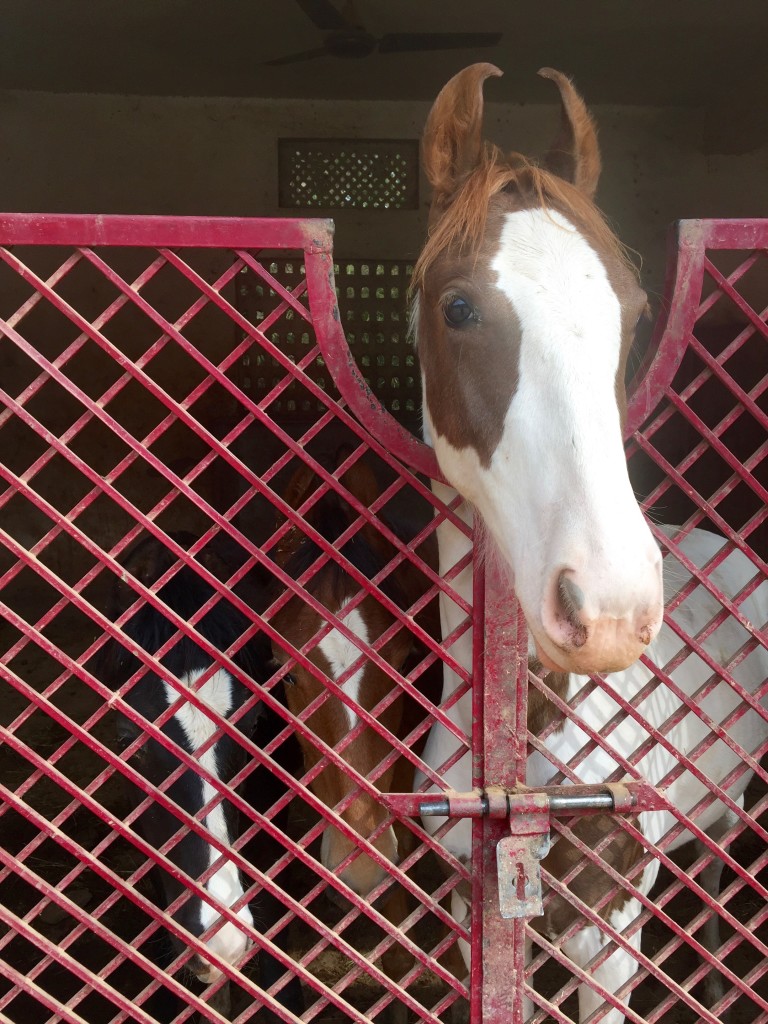
Riding Lessons
Each morning and afternoon, we all crowded under the wide umbrella of a magnolia tree for lessons from Inder Jit. Dinesh and several grooms helped facilitate the lessons, sprinting alongside high-spirited horses and calling out instructions to the riders. They generally kept three horses going at a time, giving the students 5 to 10 minutes of practice each.
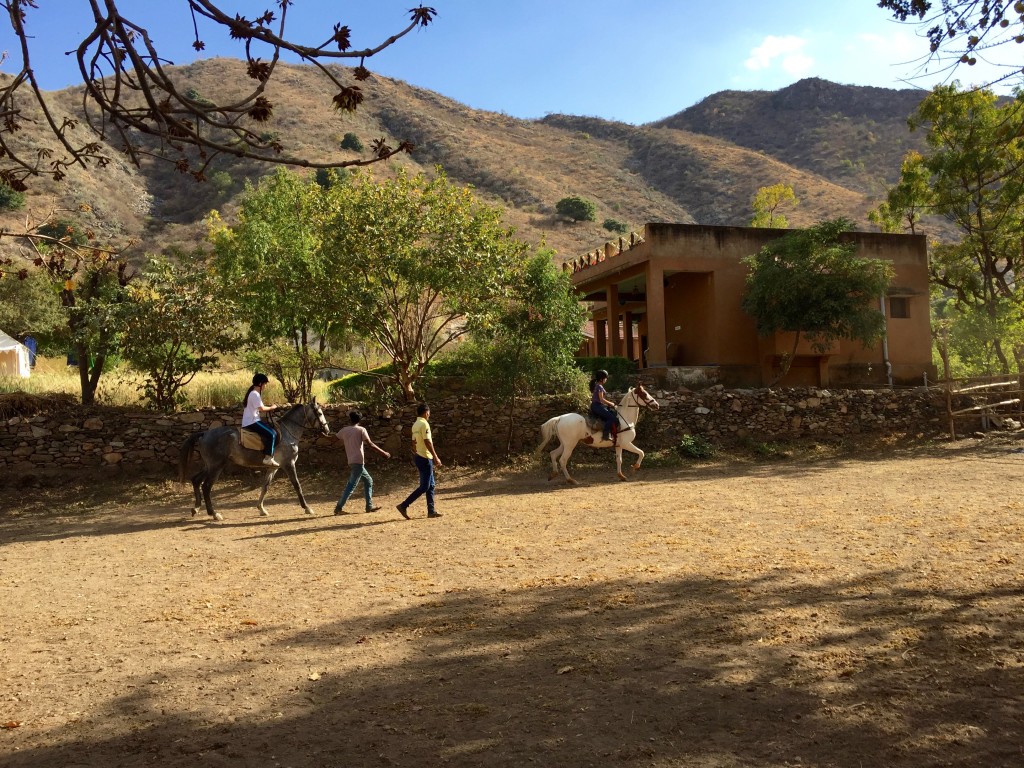
Early in our relationship, I took Tony horseback riding. He walked his horse to the middle of the field, dropped the reins and let his horse eat grass while I cantered around him for an hour. You can imagine my surprise when he confidently leapt up on his Marwari horse at Krishna Ranch and took off around the arena. After four years of chaperoning this trip, he has acquired a pretty substantial set of horsemanship skills. That’s my cowboy.
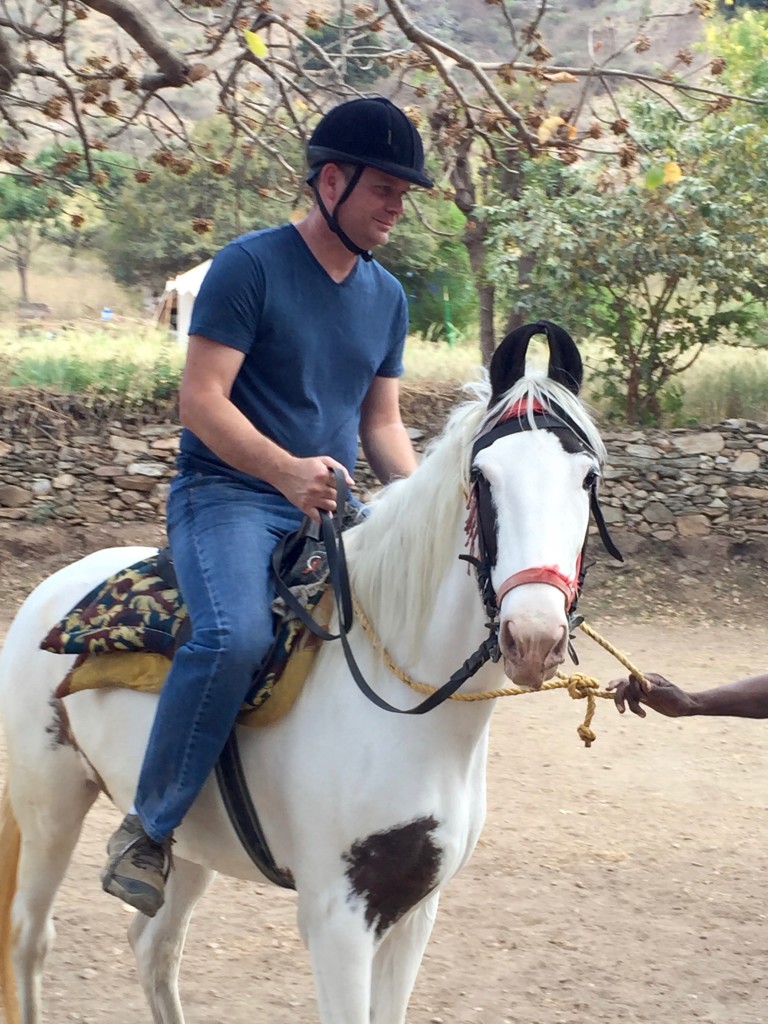
During the first lesson, my horse clearly wanted to exit the arena and get back to her friends at the stable. Dinesh told me to make the turn sooner, rather than riding the whole length of the ring. “Then she will know what you want,” he said. When my turn finished, we chatted more about that. He mentioned that he’s been working with Bollywood directors who need horses for their films. The director often just wants to start shooting as soon as the horse shows up, but Dinesh asks, “What will you want this horse to do?” Then he puts a trained rider on the horse to practice the scene several times before any filming starts. When it’s time for the actor to do it, the horse knows what to do.
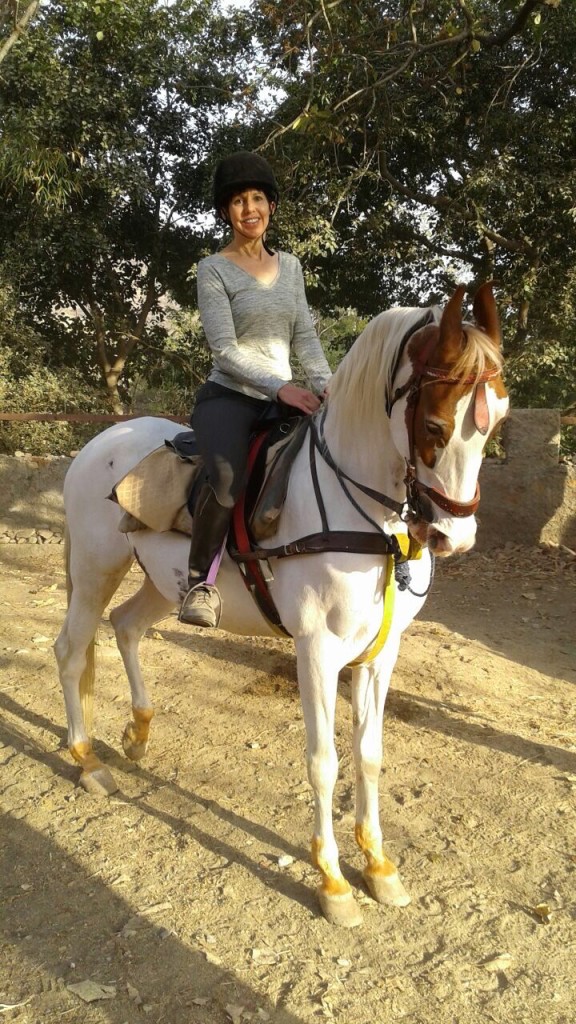
Side note: John C. Reilly recently spent some time here with Dinesh, getting riding lessons and then shooting scenes for “The Cowboys,” a French film that came out earlier this year. “Some of our guys had to dress in Pakistani clothes with guns and everything,” Dinesh said.
One afternoon, we all struggled with the horses during our lesson. They were refusing directions, bucking, spooking at the fence line, bolting, and even rearing a bit. The kids got pretty nervous and started gasping and worrying when they watched their friends take turns. (A scary cow was hanging around on the other side of the arena’s wall.) As the last rider, I was ready to opt out. By then, the horses were full-on wacko. But Dinesh convinced me to climb aboard a skittish bay mare named Rani. He helped me convince Rani to turn left when she really wanted to turn right, which we practiced several times. After she realized she wouldn’t get her way, she completely relaxed and let me take control. Once again, I recognized Dinesh’s gentle genius.
Hack Rides
Between lessons, we went on a “hack,” or trail ride, each day.
Day 1: We rode single file with a groom walking alongside each horse to the nearby village of Bada Havala. I was assigned to Noori, a stubborn pinto, and told to take up the rear. We were supposed to keep a horse length between us, but Noori really wanted to get to the front of the line. I managed to keep her under control, just barely, but I bloodied a knuckle in the battle, and I worried that I was hurting her mouth by holding the reins so tightly. When we stopped to walk around another village, Chorta Havala, I whined to Dinesh. He told me to trade horses with Bijay, one of our tour assistants (and expert horseman/polo star). I swallowed my pride and rode Suresh, a gray gelding, for the rest of the hack (and the subsequent hacks). Calm and gentle, Suresh allowed me to relax and enjoy the scenery.
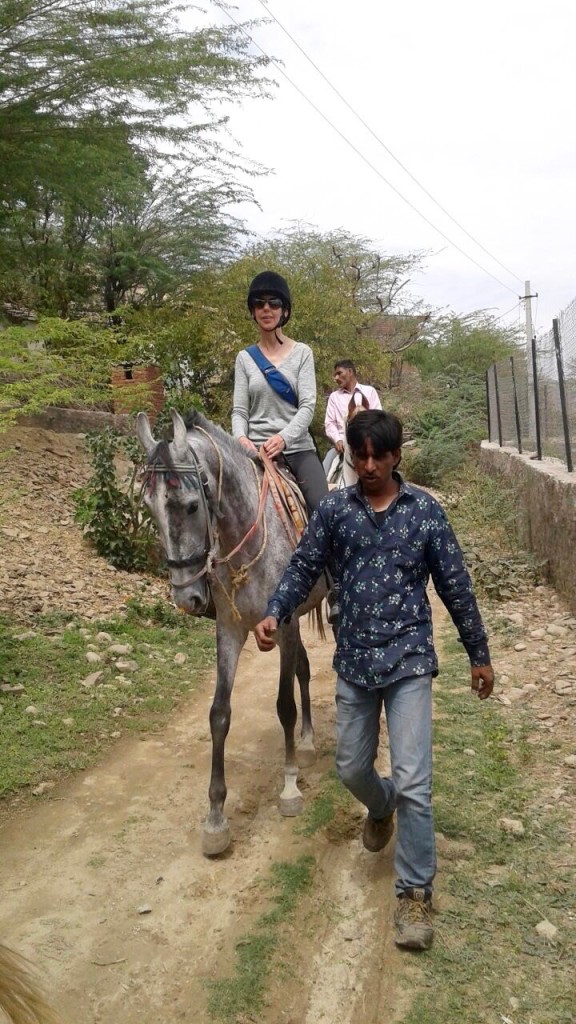
As we clomped through the villages and countryside, young children bounded out of their homes to wave and shout, “Hello! Bye bye! Dada!” (One of our students told me “dada” is like “ta ta” in English.) We passed homes of newlyweds where the outside walls were painted with a traditional wedding procession – camel symbolizing love, elephant symbolizing good luck, and horse symbolizing virility One house also had the groom on a horse and the bride being carried in a palanquin. “They can’t afford the real procession like a maharaja, so they paint it instead,” Dinesh explained.
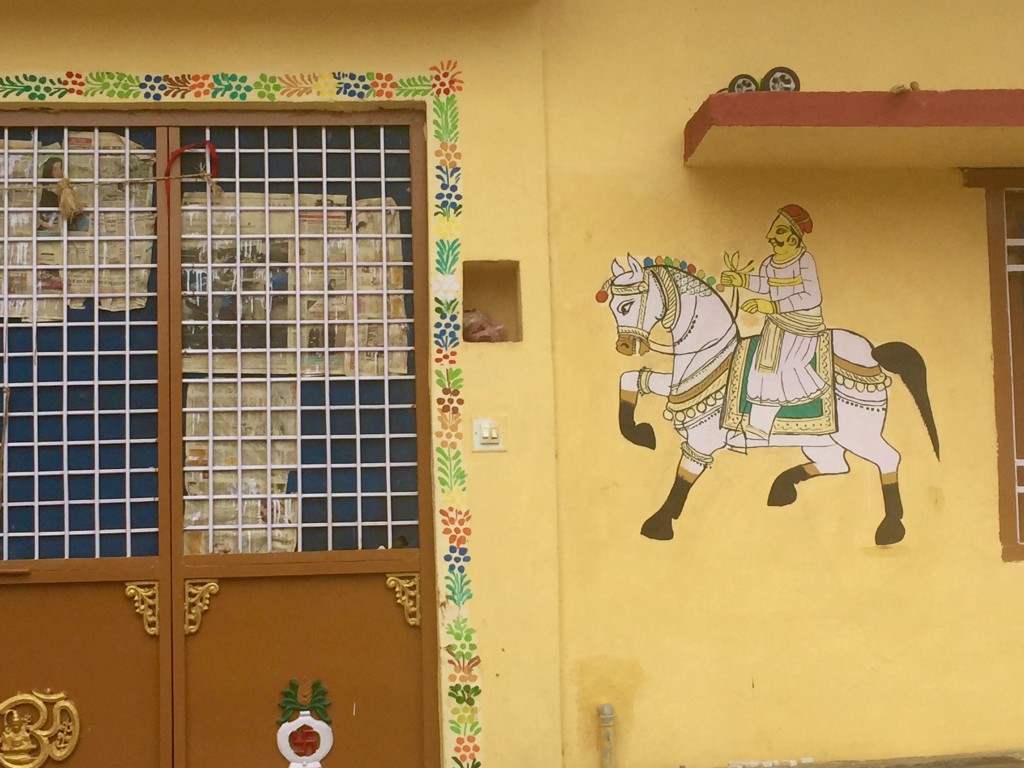
On our ride and walk, we noticed many animals with painted horns, most notably some bullocks with very long pointed horns painted bright orange, red and blue. Dinesh said the paint was a remnant of Diwali, the most sacred Hindu holiday. Farmers celebrate by decorating their hard-working animals in a show of gratitude. That includes expensive paint on the horns, henna decorations on their legs, beaded necklaces and other adornments. Another fun farmer tradition at Diwali: They set up a puja, or shrine, in front of the home, using animal dung to form idols of the gods and adding a little incense and other props. Then they open the gate and let their animals parade out of the courtyard to trample the puja and track dung down the path, leaving a temporary reminder to neighbors of their animal-owning status.
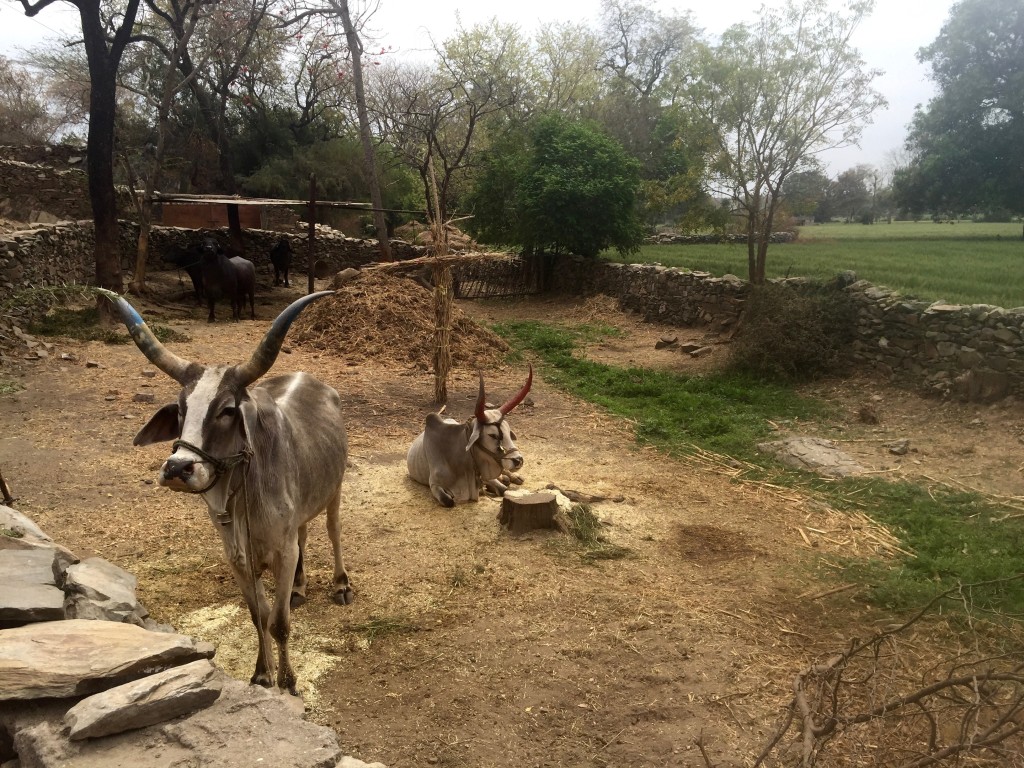
Day 2: Our group filed out the Krishna Ranch gate and on to the trail on the same horses we had yesterday. We rode to “Shilpgram – The Rural Arts and Crafts Complex,” a sprawling representation of villages in Western India. The place was mostly deserted, and the students were mostly apathetic. Still it was interesting to see how many villages cluster homes around a courtyard with a few key industries. According to the Shilpgram website, “Traditional village life was said to have been, to a considerable extent, self-contained and self-sufficient with a potter, a carpenter, a blacksmith, often a weaver, living alongside one another.”
Our silly students posing at the sculpture garden.
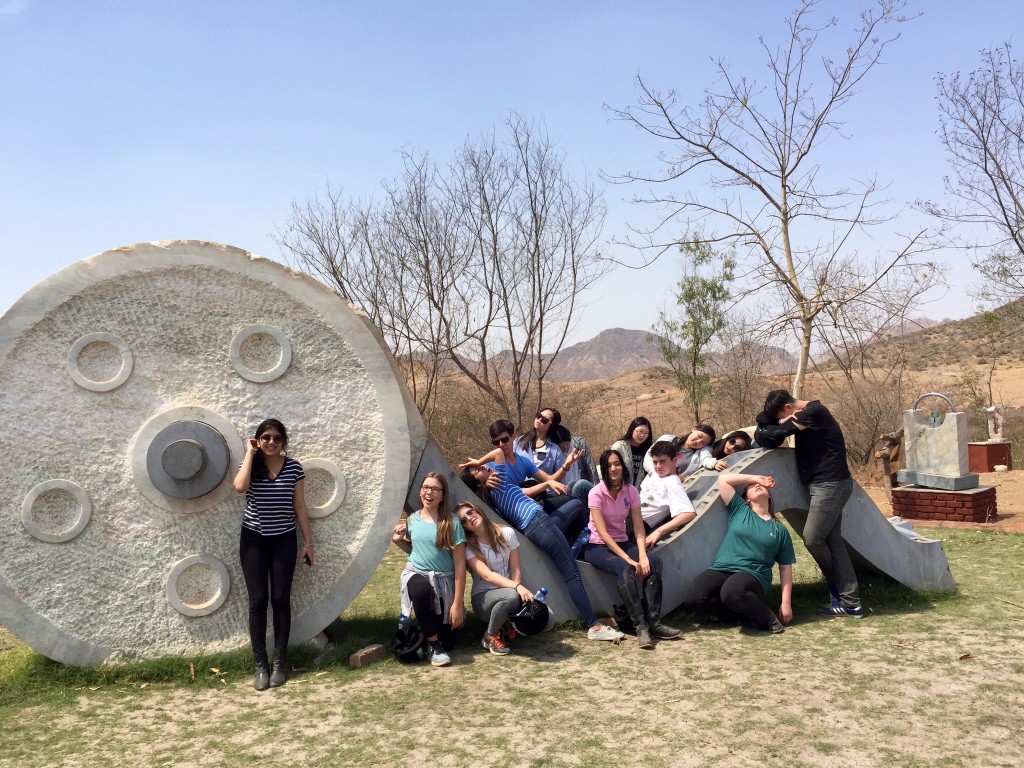
Back at the ranch, grooms unsaddled the horses and let them take turns rolling in a pile of sand to cool off. The horses looked ecstatic as they shimmied their sweaty backs down into the sand, kicking their legs in the air, but when they stood up again they were caked with grit.
After lunch, we returned to our horses for a brushing session. The grooms showed us the technique: vigorous curry combing for about 40 minutes on each side, followed by a softer brush. Suresh stood patiently while I groomed him and actually fell asleep while I gently stroked his chin. Sweet boy.
Day 3: This was my favorite trail ride. Astride our hyper steeds, we traipsed through the countryside and up into the hills to Badi Lake, a man-made reservoir that provides irrigation water to farmers in the valley. We passed the most fascinating people and scenery along the way.
Stone walls enclosed small fields of wheat, which were just beginning the transformation from green to golden. Bougainvillea draped over fences and climbed up walls, adding a splash of fuchsia, coral, baby pink and white to the dry, dusty landscape. At one point, it created a canopy overhead, dropping neon leaves on the path like a natural red carpet. Herds of little goats scrambled up the hillsides or mewed at us from their tethers. Water buffalo with curlicue horns lounged in the shade of their enclosures. Always a little cranky looking, they raised their noses in the air, rolled their eyes, and flapped their ears when alerted to our presence. We passed a camel that was nearly obscured by the towering cargo of hay on its cart. One enclosed field was cleared and brown but featured one towering tree, planted in a concrete ring, with branches bare of leaves but fiery with saffron blooms that rained down on the parched earth. The scene looked like a sepia snapshot with a Photoshopped splash of orange.
Village ladies always catch my eye as they labor in the fields or around their homes dressed in colors that offset the drudgery. Several times, a woman would hear our hoofbeats, pop up from the wheatfield, pull her dupatta up over her head and wave with a big smile. Others crouched by the irrigation channels to wash blankets, which they draped over the bushes to dry. Heads piled high with freshly harvested greens, a few ladies emerged from the fields and paused to watch us pass. Many stood roadside with their children. All wore saris in shocking hues of mainly red, orange and yellow.
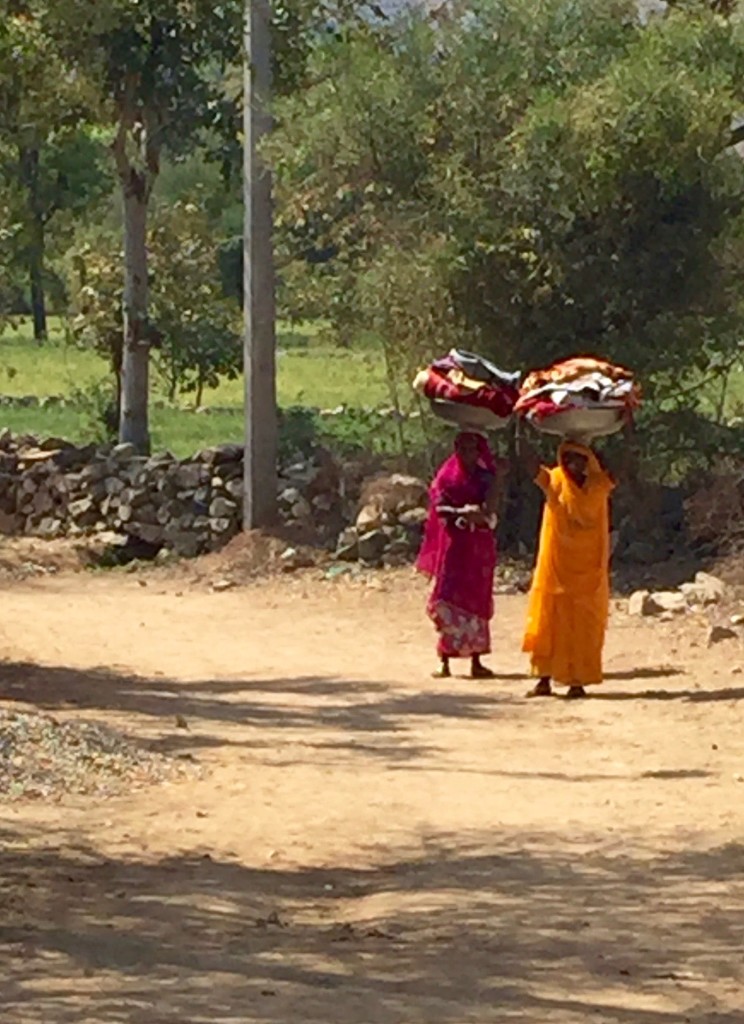
We took a short break to check out the reservoir. Tony noted that the water level changes dramatically, depending on rainfall during the monsoon season. He pointed to a small temple near the shoreline, almost completely submerged with only a bit of its spire poking out of the water. “I’ve been here when the water is below that temple,” he said. “And I’ve been here when the water was up to the edge of this path.”
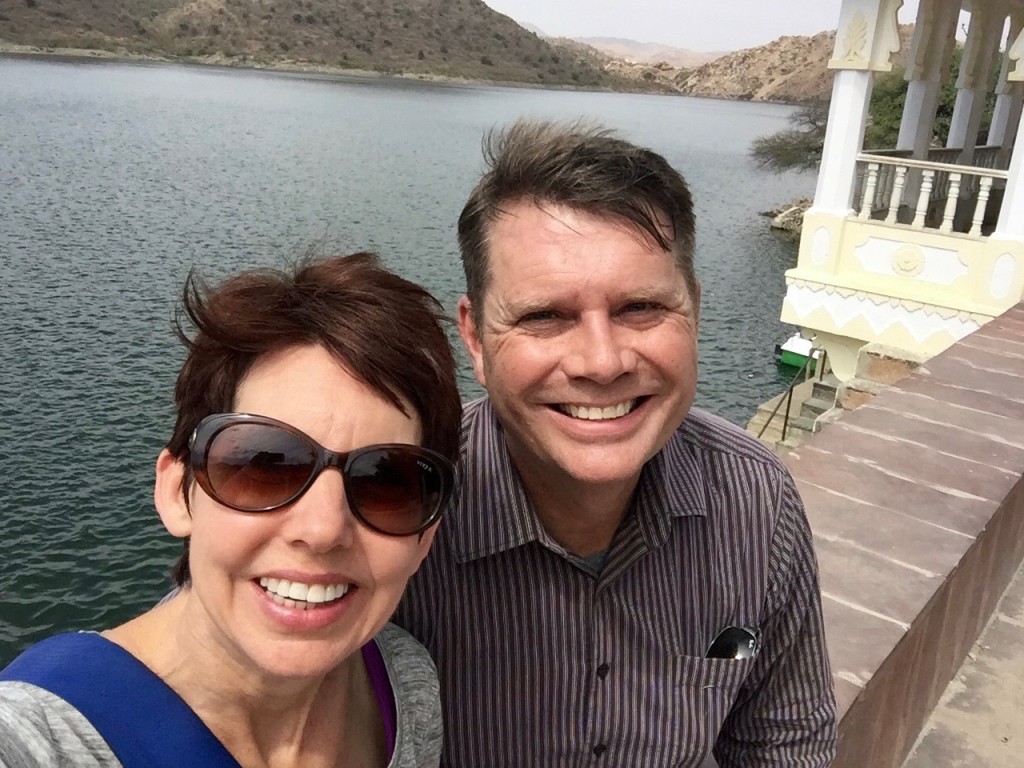
Down Time
Between lessons and rides, we sat on our porch or strolled around the property. Our building’s exterior was painted with traditional Rajasthani designs, including glued-on little round mirrors, and the jhali screen above the door featured an image of Ganesh. Sparrows had stuffed sticks and other debris inside the jhali (a mesh screen on the inside kept it all from falling on the bedroom floor), and they flitted in and out of the nest. It was like having pet birds that could come and go as they pleased.
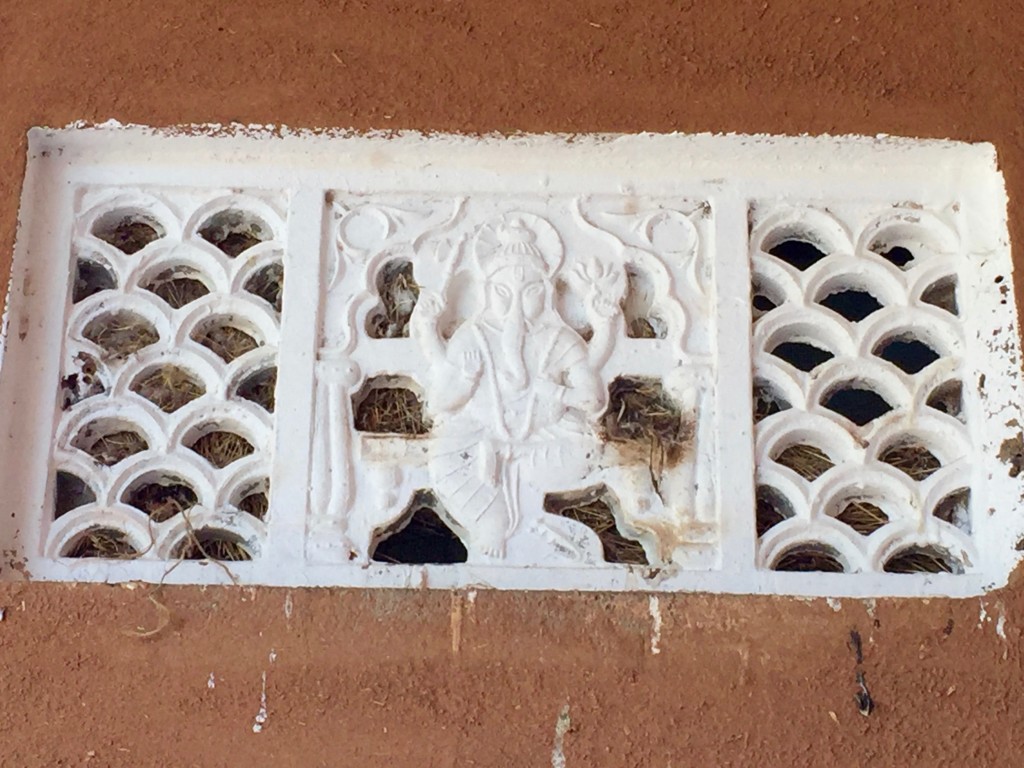
Sitting in rattan chairs on our porch, we overlooked a large garden, where the cook, Narani, might be digging up onions or picking chilis. Next to the garden, workers collected water from a pump to wash big pots or to give the horses a drink. On the far side of the garden stood a long row of stalls, where horses lay in the straw or stood with their heads hanging out the windows, calling to their friends. To the right of our porch, just under our bedroom window, a farrier trimmed the horses’ hooves and tacked on new shoes. Cookie, the puppy that wandered on to the property one day and never left, curled under a tree to gnaw on the discarded trimmings. (Dinesh said the puppy enjoys riding in the saddlebag on multi-day horse safaris.)
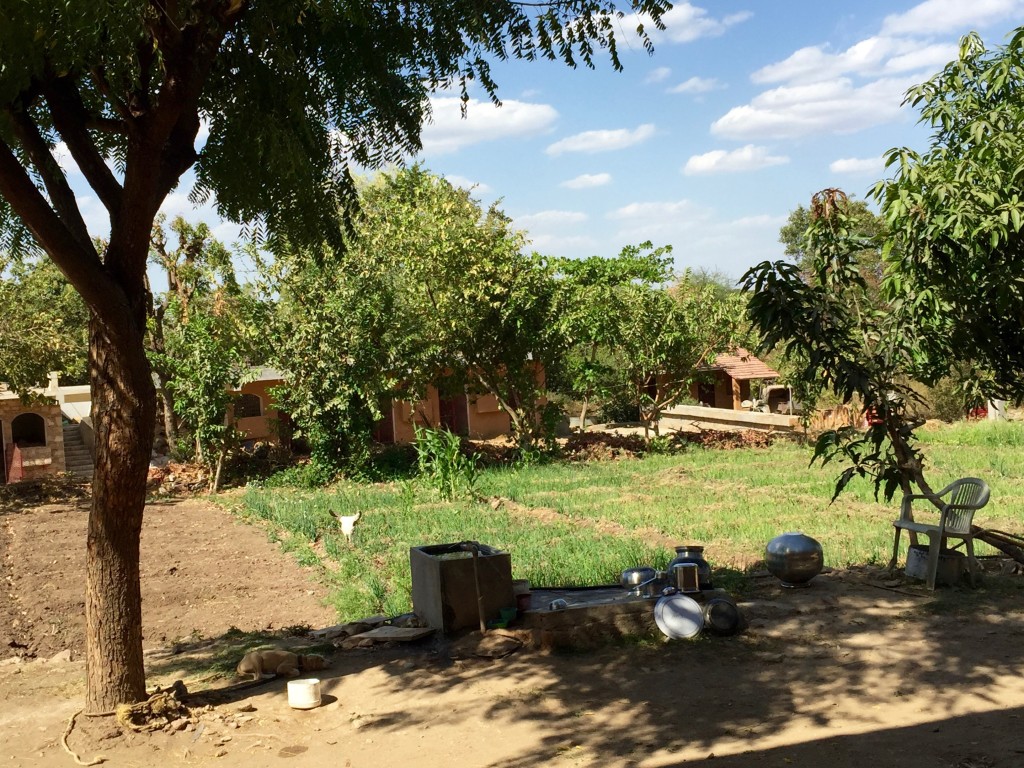
Climbing to the roof of another building, we watched huge langur monkeys leaping from tree to tree and then pausing to snack. We gasped as a tiny baby monkey held on for dear life when its mother soared through the air, grabbed for a branch and swung to a perch. From our vantage point, we watched the soft green wheat sway in the breeze while peacocks wandered through the fields.
Behind our building, additional horses were tied up, along with a baby camel and a menagerie of chickens, goats and dogs. Watching the baby goats was better than TV.
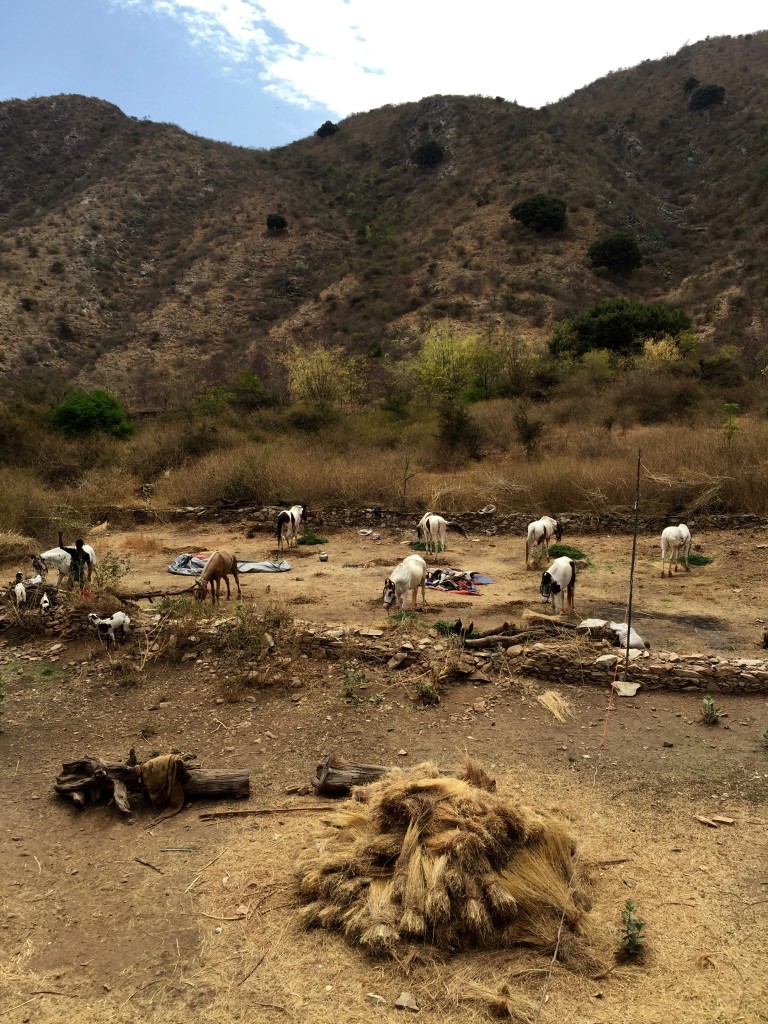
On the rooftop of our building, we ate meals, lingered over chai and played Uno in the evening as the sun set behind the Aravelli hills.
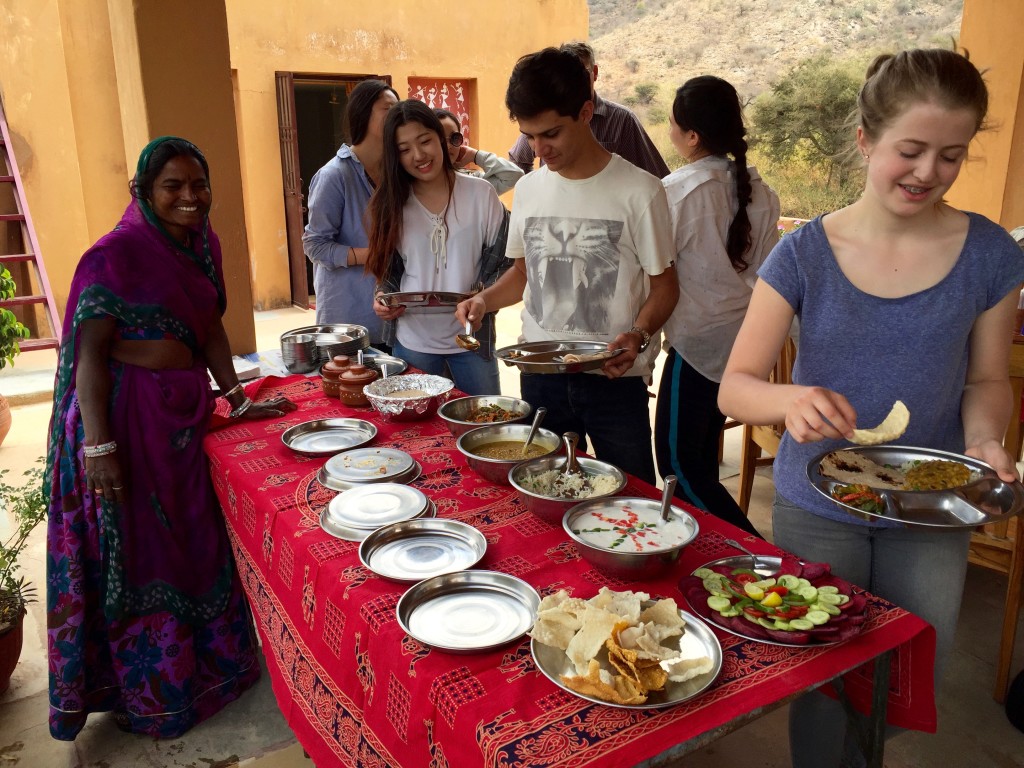
On our final night at the ranch, Dinesh built a campfire for us. The kids roasted marshmallows, sang songs, pointed out constellations, and told stories.
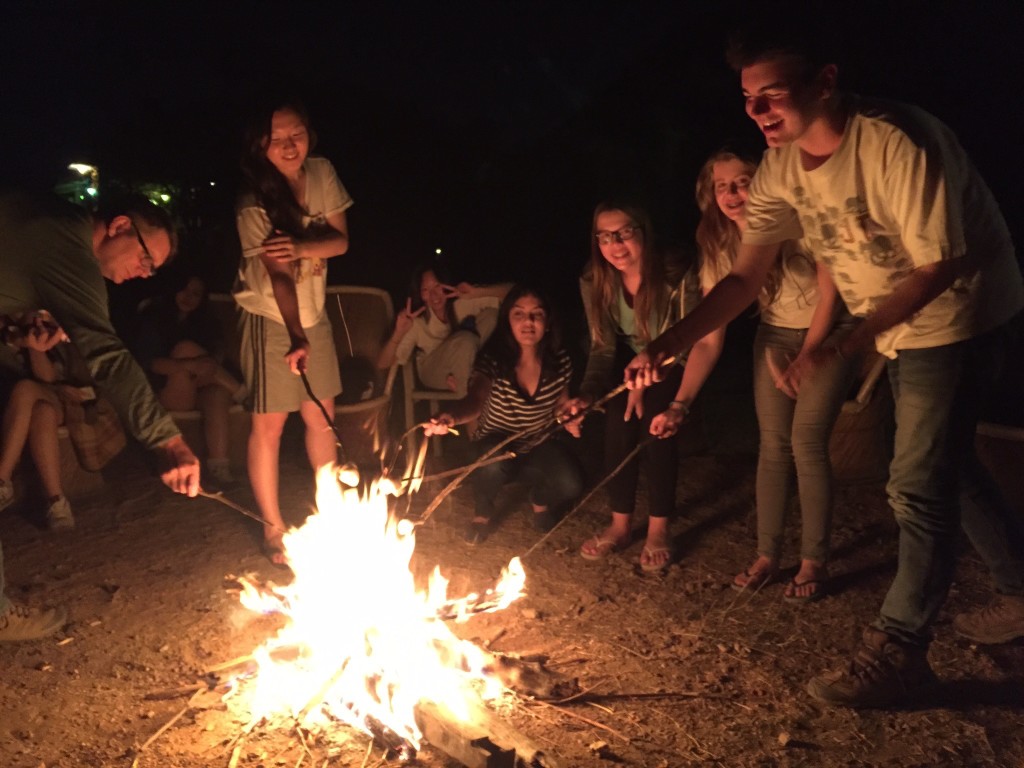
Honey, I bought a camel.
Wandering slowly back to our room one evening, we encountered Dinesh and Francine. At the same time, the young camel came ambling down the path, led by one of the grooms.
“What do you do with that camel?” Tony asked.
“Even we don’t know what to do with it!” said Francine. “We’ll get rid of it, I think. They can be quite dangerous. Look!” The camel was tugging on the lead, trying to run.
We all followed the camel down to a small paddock. The groom let the camel loose inside, where it bucked and popped in the air, gangly legs kicking out at unpredictable angles. The puppy Cookie tentatively trotted into the paddock, ears perked at this curiosity, but then bolted under the fence when the camel’s wild thrashing came too close.
Although we all had a good giggle at the goofy camel, Francine repeated her protest about camel ownership. Tony and I joked about how most husbands get in trouble for buying a tech gadget or other expensive toy without asking their wives.
“How did you break the news when you brought home a camel?” we asked Dinesh.
He said the camel was a surprise even to him. He had been looking for one of his grooms, and someone announced, “He went to get the camel.” Sure enough, the groom showed up later with the baby camel that charmed its way into permanent residence at Krishna Ranch.
“He really was so cute and little,” said Francine.
Although the little camel is still too young to be useful, Dinesh plans to use him for hauling cargo on multi-day horse safaris in the future. “That is a good idea,” Francine conceded.
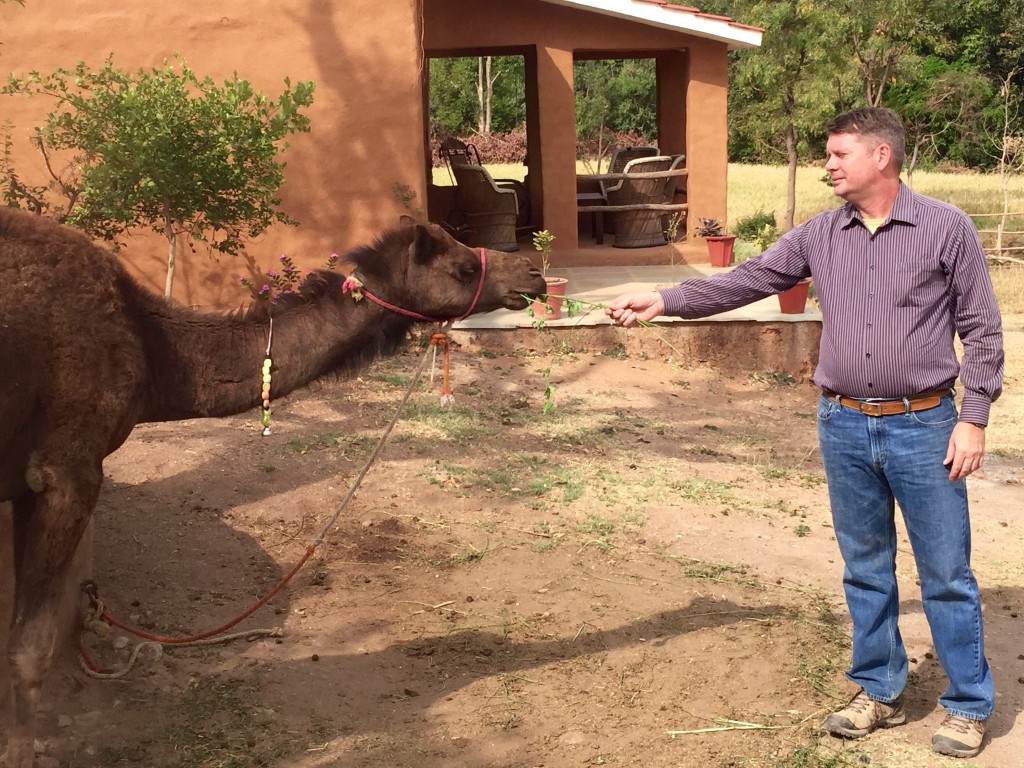
Farewell
On the afternoon of our departure, some of the handlers demonstrated a few tricks. Dinesh said the horses often perform at weddings – dancing, bowing, rearing up high, and walking on their back legs. Then we gathered all the workers and our group together to express our gratitude. Our only Hindi-speaking student shared our appreciation and understanding that their long hours and hard work led to such a meaningful visit for us. We all shook hands, enjoyed a last glass of chai, hugged our horses good-bye, and trudged down the dusty path to meet our bus.
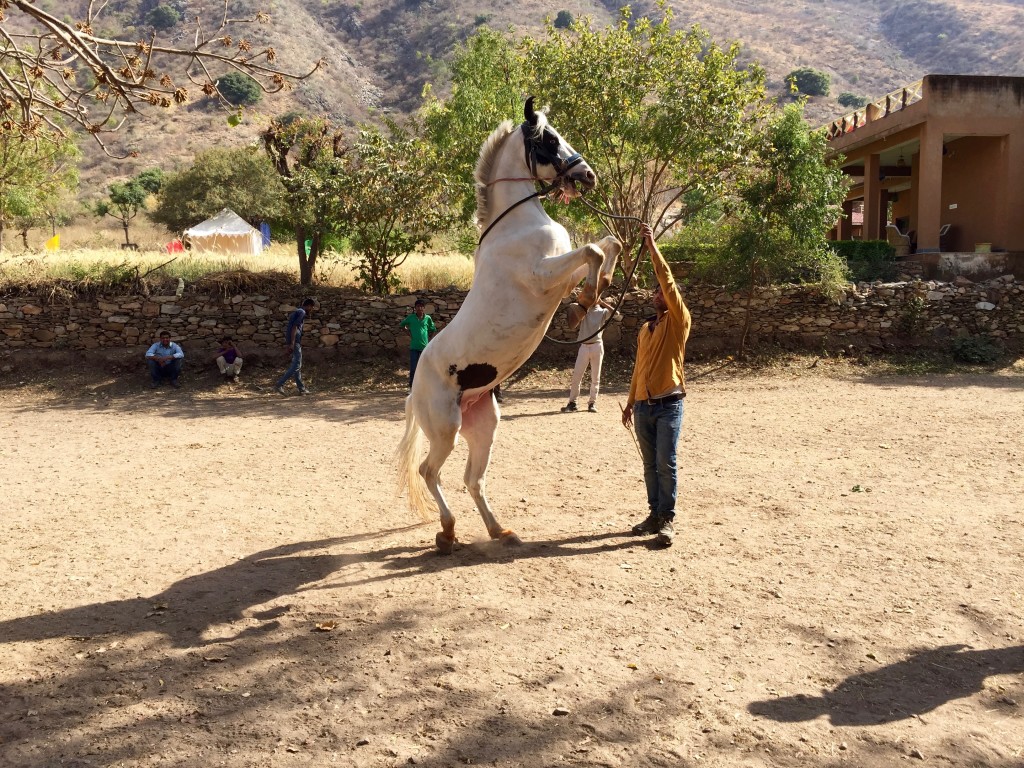
A short flight later, we were back in Delhi, saddle sore but filled with bliss.

